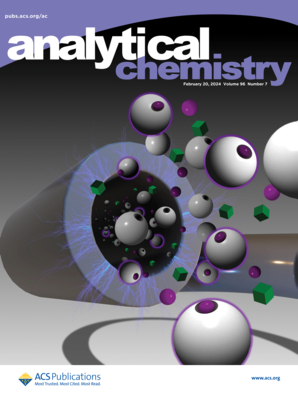Polarity Sensor Based on Multivariate Lanthanide Metal–Organic Framework for Constructing Biosensing Platform
IF 6.7
1区 化学
Q1 CHEMISTRY, ANALYTICAL
引用次数: 0
Abstract
It is significant but challenging to develop polarity sensors that can measure multiscenario polarity in a modular, customized, sensitive, and accurate manner. In this work, we proposed a polarity sensor based on multivariate lanthanide metal–organic framework (Ln-MOF) nanoclusters through the modular programming design of ligands. This multivariate Ln-MOF combines the advantages of modularity, ease of design, high flexibility and low cost, and can be precisely customized for different polarity systems. The MOF Eu0.1Tb0.9-isophthalic acid (IPA) and Eu0.3Tb0.7-o-phthalic acid (OPA) are suitable for the detection of trace water in dimethylsulfoxide (DMSO) and hyaluronidase activity, respectively. Especially, Eu0.3Tb0.7-OPA can achieve high-sensitivity detection of hyaluronidase activity within 8 min, with the limit of detection as low as 0.016 U/L. The results enable us to break through our previous understanding of polarity parameter, allowing us to develop more polarity-related biosensing platforms. Ln-MOFs are believed to utilize their adjustable polar intermolecular interactions to achieve the optimal compatibility and high sensitivity in polarity sensing systems, which is supported by experiments and density functional theory calculations. These polarity sensors based on multivariate Ln-MOF nanoclusters offer significant potential in biosensing and medical diagnostics, overcoming traditional biosensor limitations in synthesis and customization.

基于多元镧系金属-有机框架的极性传感器构建生物传感平台
开发能够以模块化、定制化、敏感和精确的方式测量多场景极性的极性传感器意义重大,但也具有挑战性。在这项工作中,我们通过配体的模块化编程设计,提出了一种基于多元镧系金属有机框架(Ln-MOF)纳米簇的极性传感器。这种多变量Ln-MOF结合了模块化、易于设计、高灵活性和低成本的优点,可以针对不同的极性系统进行精确定制。MOF eu0.1 tb0.9 -二苯二甲酸(IPA)和eu0.3 tb0.7 -邻苯二甲酸(OPA)分别适用于痕量水中二甲基亚砜(DMSO)和透明质酸酶活性的检测。其中,Eu0.3Tb0.7-OPA可在8 min内实现透明质酸酶活性的高灵敏度检测,检出限低至0.016 U/L。该结果使我们能够突破以往对极性参数的理解,使我们能够开发更多与极性相关的生物传感平台。实验结果和密度泛函理论计算均支持了ln - mof利用其可调节的极性分子间相互作用实现极性传感系统的最佳相容性和高灵敏度。这些基于多元Ln-MOF纳米簇的极性传感器在生物传感和医学诊断方面具有巨大的潜力,克服了传统生物传感器在合成和定制方面的局限性。
本文章由计算机程序翻译,如有差异,请以英文原文为准。
求助全文
约1分钟内获得全文
求助全文
来源期刊

Analytical Chemistry
化学-分析化学
CiteScore
12.10
自引率
12.20%
发文量
1949
审稿时长
1.4 months
期刊介绍:
Analytical Chemistry, a peer-reviewed research journal, focuses on disseminating new and original knowledge across all branches of analytical chemistry. Fundamental articles may explore general principles of chemical measurement science and need not directly address existing or potential analytical methodology. They can be entirely theoretical or report experimental results. Contributions may cover various phases of analytical operations, including sampling, bioanalysis, electrochemistry, mass spectrometry, microscale and nanoscale systems, environmental analysis, separations, spectroscopy, chemical reactions and selectivity, instrumentation, imaging, surface analysis, and data processing. Papers discussing known analytical methods should present a significant, original application of the method, a notable improvement, or results on an important analyte.
 求助内容:
求助内容: 应助结果提醒方式:
应助结果提醒方式:


